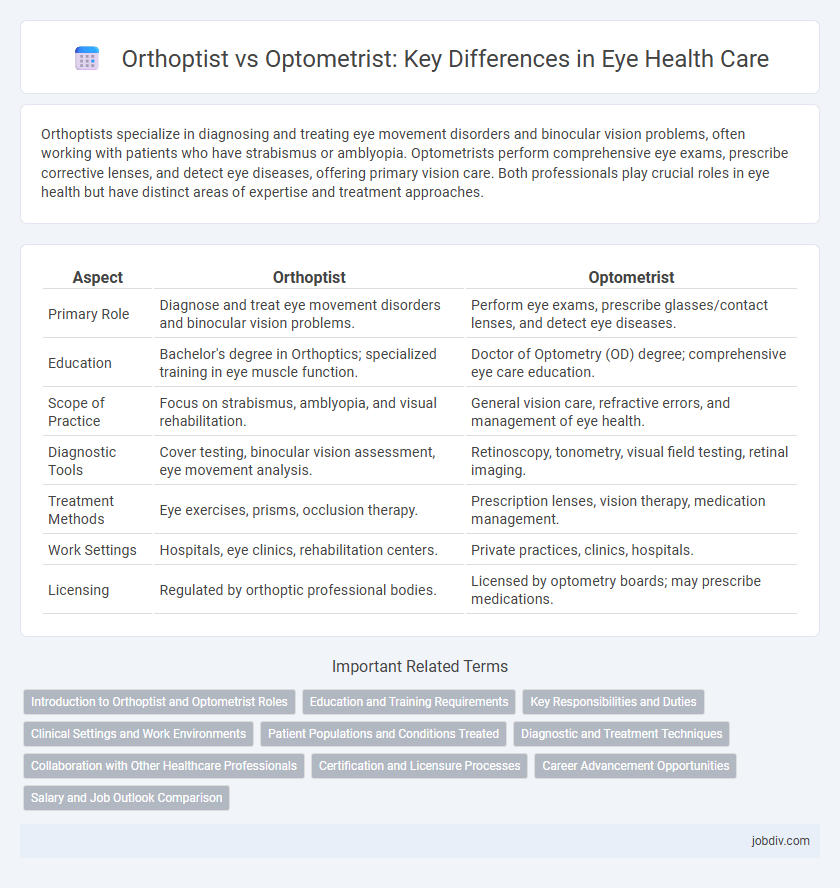Orthoptists specialize in diagnosing and treating eye movement disorders and binocular vision problems, often working with patients who have strabismus or amblyopia. Optometrists perform comprehensive eye exams, prescribe corrective lenses, and detect eye diseases, offering primary vision care. Both professionals play crucial roles in eye health but have distinct areas of expertise and treatment approaches.
Table of Comparison
| Aspect | Orthoptist | Optometrist |
|---|---|---|
| Primary Role | Diagnose and treat eye movement disorders and binocular vision problems. | Perform eye exams, prescribe glasses/contact lenses, and detect eye diseases. |
| Education | Bachelor's degree in Orthoptics; specialized training in eye muscle function. | Doctor of Optometry (OD) degree; comprehensive eye care education. |
| Scope of Practice | Focus on strabismus, amblyopia, and visual rehabilitation. | General vision care, refractive errors, and management of eye health. |
| Diagnostic Tools | Cover testing, binocular vision assessment, eye movement analysis. | Retinoscopy, tonometry, visual field testing, retinal imaging. |
| Treatment Methods | Eye exercises, prisms, occlusion therapy. | Prescription lenses, vision therapy, medication management. |
| Work Settings | Hospitals, eye clinics, rehabilitation centers. | Private practices, clinics, hospitals. |
| Licensing | Regulated by orthoptic professional bodies. | Licensed by optometry boards; may prescribe medications. |
Introduction to Orthoptist and Optometrist Roles
Orthoptists specialize in diagnosing and treating disorders of eye movement and binocular vision, including conditions like strabismus and amblyopia, primarily working with children and patients requiring vision therapy. Optometrists provide comprehensive eye exams, diagnose refractive errors such as myopia and hyperopia, and manage eye diseases like glaucoma and diabetic retinopathy, often prescribing corrective lenses and medications. Both professionals play crucial roles in eye care, with orthoptists focusing on functional vision problems and optometrists addressing overall eye health and visual acuity.
Education and Training Requirements
Orthoptists typically complete a bachelor's degree in orthoptics or a related field followed by specialized training focusing on diagnosing and managing binocular vision disorders and eye movement abnormalities. Optometrists undergo a more extensive education pathway, earning a Doctor of Optometry (OD) degree usually after four years of undergraduate study, with comprehensive training in eye health, vision care, and prescribing corrective lenses or medications. Both professions require licensure, but optometrists have broader medical training, enabling them to perform eye exams, detect ocular diseases, and provide primary vision care services.
Key Responsibilities and Duties
An orthoptist specializes in diagnosing and treating binocular vision disorders such as strabismus and amblyopia, focusing primarily on eye movement and coordination therapy. Optometrists perform comprehensive eye exams, prescribe corrective lenses, and detect eye diseases like glaucoma and cataracts, providing primary vision care. Both professionals collaborate with ophthalmologists but have distinct roles in vision therapy and eye health management.
Clinical Settings and Work Environments
Orthoptists primarily work in clinical settings such as hospitals and specialized eye clinics, focusing on diagnosing and treating binocular vision disorders and eye movement abnormalities. Optometrists often practice in a broader range of environments, including private practices, retail optical stores, and community health centers, providing comprehensive eye exams, prescribing corrective lenses, and managing common eye diseases. Both professionals collaborate closely with ophthalmologists but differ significantly in the scope and setting of their clinical work.
Patient Populations and Conditions Treated
Orthoptists specialize in diagnosing and treating binocular vision disorders, such as strabismus and amblyopia, primarily in pediatric and neurologically impaired patients. Optometrists provide comprehensive eye care, including vision correction, management of refractive errors, and screening for ocular diseases like glaucoma and diabetic retinopathy in a broader patient population. Both professionals collaborate to optimize visual health, but orthoptists focus more on eye movement and coordination issues, while optometrists address overall eye health and vision care.
Diagnostic and Treatment Techniques
Orthoptists specialize in diagnosing and treating binocular vision disorders, primarily using techniques such as eye movement analysis and vision therapy to address issues like strabismus and amblyopia. Optometrists perform comprehensive eye exams, utilizing tools like retinoscopy and ophthalmoscopy to detect refractive errors, eye diseases, and systemic conditions affecting vision. Both professionals play critical roles in eye care, with orthoptists focusing more on neuromuscular and binocular function while optometrists provide broader diagnostic services and prescribe corrective lenses or medications.
Collaboration with Other Healthcare Professionals
Orthoptists collaborate closely with ophthalmologists and neurologists to diagnose and treat eye movement disorders, optimizing patient outcomes through interdisciplinary care. Optometrists work alongside primary care physicians and specialists to manage vision correction, ocular diseases, and systemic health conditions affecting the eyes. Effective collaboration between orthoptists, optometrists, and other healthcare professionals enhances comprehensive eye care and facilitates early detection of underlying health issues.
Certification and Licensure Processes
Orthoptists undergo specialized training focusing on diagnosing and managing eye movement disorders, typically requiring certification through organizations like the American Orthoptic Council and state licensure. Optometrists complete a Doctor of Optometry (OD) degree, followed by passing national board examinations and obtaining state licensure to perform comprehensive eye exams and prescribe corrective lenses. Certification and licensure for both professions ensure adherence to clinical standards and patient safety in vision care services.
Career Advancement Opportunities
Orthoptists often advance by specializing in pediatric or neurological vision disorders, leading to roles in hospitals or multidisciplinary clinics. Optometrists may pursue career growth through advanced certifications in specialties such as glaucoma, contact lenses, or vision therapy, expanding their scope of practice and private practice opportunities. Both professions benefit from continuous education and collaboration with ophthalmologists to enhance patient care and career prospects.
Salary and Job Outlook Comparison
Orthoptists typically earn an average salary ranging from $60,000 to $80,000 annually, while optometrists report higher earnings, often between $110,000 and $130,000 per year. Job outlook for optometrists is strong, with a projected growth rate of 10% over the next decade, driven by an aging population and increased demand for vision care. In contrast, orthoptist job growth is more specialized and steady, with a focus on pediatric and neurological eye disorders, reflecting limited but stable employment opportunities.
Orthoptist vs Optometrist Infographic

 jobdiv.com
jobdiv.com